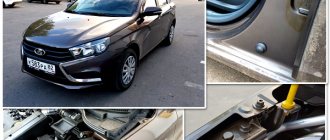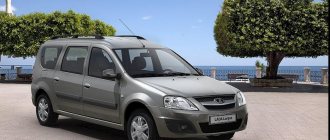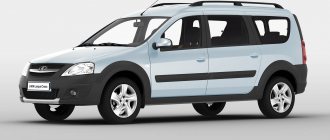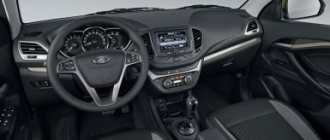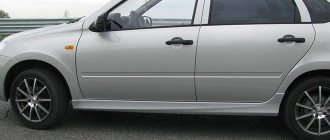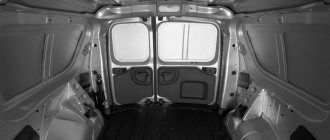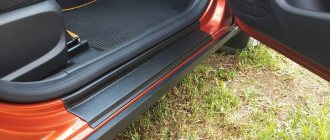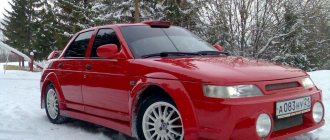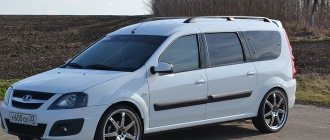Car : Lada Largus. Asks : Alexander Ushakov. Question : does the Lada Largus have a galvanized body or not?
On my Largus station wagon, after the fender was scratched, the metal began to bloom for some reason. Rust appeared near the chip site. Isn't the body of the Lada Largus galvanized?
In different brochures they write one thing: all external panels are protected with zinc! It seems like it can’t even be any other way. But I couldn’t detect zinc on the metal where there was a scratch. What does it mean? I just want to find out who is deceiving whom.
Everything that is known about galvanizing the body of Lada cars: Vesta, Granta, X Ray and Largus
Ladas have not yet caught up with foreign cars in protecting the body from corrosion, but they are moving in this direction.
Galvanized body means covering it with scrap zinc, which provides additional protection against corrosion. Thus, the better the body is galvanized, the longer rust will not appear on it. But is it necessary to carry out additional body anti-corrosion treatment on a Lada car, or do modern models do not need this? For those who don’t want to read a lot: The frets are galvanized using the cheapest technology, which is why they rust a little better than foreign cars.
Galvanizing methods used by automakers differ. The higher the quality of galvanization of the body, the higher the cost of the car will be, and you can significantly save on using less reliable protection.
The most reliable method is hot-dip galvanizing - the metal is coated with a layer of zinc when the body is immersed in a special bath filled with molten zinc. This method is used by large manufacturers.
AvtoVAZ uses cataphoresis-type priming, when the “rough” body is dipped into a bath containing a special primer. In this case, the surface of the body is covered with a phosphate film, which acts as protection against corrosion. It is the quality of this layer that affects the durability of the body.
In addition, at AvtoVAZ, body parts are protected by cold galvanizing: a composition with zinc powder is applied to the surface. The process is somewhat reminiscent of painting.
Lada models with a galvanized body There is no exact information about how many parts are galvanized, and AvtoVAZ does not disclose them. Various indicators are mentioned, but there is no official confirmation of them. According to media reports, Lada cars have the following degree of galvanization:
VAZ-2110: 30%; Niva 2131/2121, Lada 4x4: no galvanized steel, cataphoretic priming; Kalina (first generation): 52%; Kalina (second generation): fully galvanized, except for the hood, roof, rear/front side members; Priora: models from 08.2008 – galvanized 29%, from 2009 – 100%; Largus: there are galvanized parts, which ones are unknown; Vesta: the outer body layer is completely galvanized (sedan - with a non-galvanized roof, station wagon - fully galvanized), the bottom and sills are with anti-gravel protection; Xray: external body elements are completely galvanized, with the exception of the roof.
And now what is officially known:
Granta (sedan): galvanized steel makes up 32% of the weight of all body parts. The share of hot-dip galvanized steel with double-sided coating from galvanized metal is 75%. The bottom is treated with a durable and strong anti-gravel coating, in hidden cavities there is anti-corrosive coating; Granta (liftback): galvanized steel in the sidewalls, mudguards and bottom, high-strength steel in the load-bearing body frame; Xray: external body panels are double-sided galvanized; anti-corrosive coating is applied in hidden cavities and on the bottom.
Alternative data before 1999: AvtoVAZ did not galvanize bodies; only an anti-corrosion coating was applied; 1999-2009: cold galvanizing is used with processing of part of the node connections; since 2009: more elements are processed by cold galvanizing, including parts of the body most susceptible to corrosion, joint connections, bottoms of doors, bottoms, sills, etc. Particular attention Improvements in technology are observed from year to year, warranty obligations regarding body rust are increasing, which affected and AvtoVAZ. Pay attention to whether there is such a guarantee, and do not believe advertising and dubious information about galvanizing.
The body warranty for today's Lada models is 6 years. However, service life may vary depending on how well the body is treated and where the vehicle is driven. If rust is found within the warranty, notify your dealer immediately.
Source
A used foreign car or a new domestic one
If you still buy a VAZ, which one is preferable?
I don’t want to advertise AvtoVAZ now, but cars are now actually being made at the level of Solaris, Rio, Almera.
Let's remember how fantastic sums of money were poured into our famous AvtoVAZ to lift our automobile industry off its knees. Amounts amounting to tens of billions per year. But this plant produced poor little cars with many problems. Viburnums, Grants, Priors. It was somehow insulting to receive such squalor for our money.
But time has passed, and we see that cars have really become better. It turns out that the major owner of AvtoVAZ shares is Renault-Nissan. The state is now pouring ten times less into it. And the Renault-Nissan company fights hard for quality. Whatever one may say, Lada is the best-selling brand in our country. And the price and quality became almost ideal.
Lada Vesta, the car is good, rest assured. This is not Granta, not Kalina or Priora. The car costs 500,000 rubles, now the price has risen, but somewhere still within the reachable price.
The equipment is quite decent. Everything is like a foreign car, a beautiful seven-inch display on the dashboard, a rear view camera, heated glass, heated seats, even air conditioning.
The quality of finishing is up to par. In general, everything that corresponds to a modern car. The car corresponds to the level of both Solaris and Kia Rio and Almera. No worse. Of course, as without this, there are some problems, silent blocks, for example, creaked, but I think this can be easily fixed.
But then you get a car with a 3-year and 100,000 km warranty. By the way, with a galvanized body. AvtoVAZ’s service has been stretched, dealers do not work the same as before. The Renault-Nissan company has also changed its sales policy and maintains it at a high level.
Of course, there is a human factor, and foreign-made services sometimes have poor service, but still, having a Lada car, you will have fewer problems than you did five years ago. And it can no longer be denied that the car has become really high quality.
Of course, there is still work to be done, but overall it has gotten better. If anything breaks, then the spare parts, I must admit, are cheap. Compared to the prices of spare parts for foreign cars, this is several times cheaper.
Now a new series of cars is being produced, Lada Vesta, Largus, X-ray.
Largus and X-ray cars are B-0 class cars, this is a Renault-Nissan platform. Such a platform seems to have nothing to do with Lada, they are assembled only there. The assembly now is also many times better than it was before. Why?
But because the Renault-Nissan company terminated contracts with suppliers who produced low-quality components. Components are brought from abroad. Although, thanks to the sanctions, our manufacturers are also catching up.
AvtoVAZ is switching to our suppliers, but strictly selects them based on the quality of the parts produced. All this makes itself felt, the cars have started running better, they have become much better quality.
If you hesitate, suspecting that VAZ cars are bad, then I advise you to change your mind about our cars. You can safely buy a Lada Vesta or Lada Largus. Well, here the taste, as they say, and the color... Although Largus seems to me not very beautiful, unlike Vesta.
Galvanizing the body of VAZ Largus 1st generation
Other generations of VAZ Largus
When a galvanized surface is damaged, corrosion destroys the zinc and not the steel.
| Treatment | Type | Method | Current state | |
| 2012 | Full | Zinc metal | • application of zinc particles during steel rolling • application of a layer of oxides containing zinc particles | Processing result: Poor The car is already 9 years old. Considering the age and quality of workmanship of this car (under normal operating conditions), body corrosion has only just begun. It is difficult to notice if the car has not been subjected to shocks or scratches. |
| 2013 | Full | Zinc metal | • application of zinc particles during steel rolling • application of a layer of oxides containing zinc particles | Processing result: Poor The car is already 8 years old. Considering the age and quality of workmanship of this machine (under normal operating conditions), the first corrosion will appear after 1 year. |
| 2014 | Full | Zinc metal | • application of zinc particles during steel rolling • application of a layer of oxides containing zinc particles | Processing result: Bad The car is already 7 years old. Given the age and quality of workmanship of this machine (under normal operating conditions), the first corrosion will appear after 2 years. |
| • | Complete - the car body is processed completely, including hidden and hard-to-reach cavities. | ||
| • | Partial - all joints and the most vulnerable parts of the body, sills, bottom, bottom of doors are processed. | • | Nodal connections - includes only processing of welding points, fastenings, stampings and other small parts. |
Over time, the processing process has changed. A younger car will always be better galvanized!
| • | Hot - Best type. High corrosion resistance, resistance to mechanical stress, partial regeneration property. | ||||
| • | Galvanic - Good type. Less corrosion resistance, ideally combined with paint and primer. | • | Zinc metal - Acceptable type. Metal with an elastic zinc-based coating, weak anti-corrosion properties, resistance to mechanical stress. | • | Cold - Bad type. Anaphoretic soil with an admixture of zinc is not able to resist corrosion. |
The presence of zinc particles in the soil covering the car body does not affect its protection and is used in advertising materials. More information.
Below are the test results of cars that came off the assembly line with the same damage (cross) on the lower part of the front right door. Tests were carried out in the laboratory. The conditions in the hot salt fog chamber for 40 days corresponded to 5 years of normal operation.
Hot dip galvanized vehicle
(layer thickness 12-15 microns)
Galvanized car
(layer thickness 5-10 microns)
Cold galvanized vehicle
(layer thickness 10 µm)
Car with zinc metal
Car without galvanization
• A coating with a thickness of 2 to 10 microns provides excellent protection against the occurrence and spread of corrosion damage.
• The rate of destruction of the active zinc layer at the site of body damage is from 1 to 6 microns per year. Zinc is more actively destroyed at elevated temperatures.
• If the word “full” is not added, this means that only impact-prone body elements were treated.
• Pay special attention to the presence of a manufacturer's warranty on the car body rather than loud advertising about galvanization.
Source
Summing up
This model is one of the most affordable offerings on the market, both commercial and civilian station wagons. The car has a large number of variations, ranging from a regular station wagon to a Cross version, which significantly expands its audience coverage. Its popularity is due not only to its wide range, but also to its reliability, which has been confirmed by years of operation of units and vehicles in various climatic and road conditions. These are not sweeping words, this has been proven by many summer residents, taxi drivers and representatives of small businesses. Its closest competitors are about a third more expensive, and for the same money they offer about the same thing. It would be very interesting if the Cross version received the Lada Ride Select system and electronic differential lock. Most likely, this version would gain popularity among people living far from standard roads, and who know what snowfalls or mud are like, certainly for a reasonable price.
Is the body of LADA cars galvanized or not?
Galvanizing is the coating of metal with a layer of zinc to protect it from corrosion. In other words, the better the body is galvanized, the more resistant it is to rust. Is there a need to additionally carry out anti-corrosion treatment of the body or is this no longer relevant for modern LADA cars?
Car manufacturers use different galvanizing methods. High-quality galvanization of the body significantly affects the cost of the car; less reliable methods of protection cost factories much less.
The most reliable method is hot galvanizing , when the metal is coated with a layer of zinc by dipping the body into a bath of molten zinc at a temperature of about 460 °C. This method is used only by large manufacturers of European foreign cars.
To protect the body from corrosion, AVTOVAZ practices cataphoresis priming of the body . The “black” body is dipped into a bath with a special primer. A phosphate film is formed on the entire surface of the metal, which is the basis of the protective anti-corrosion layer of the car; the durability of the body depends on its quality.
AVTOVAZ also uses cold galvanizing of body parts. The process involves applying a composition containing zinc powder to the surface. This method can be called high-quality body painting using anti-corrosion additives.
Advantages
The power part of the car is characterized by a long service life, amounting to hundreds of thousands of kilometers. In this case, the weak link is the body.
After only 2-3 years of operation, rust appears on it, which requires urgent repairs and subsequent touch-up of problem areas.
To extend the life of metal, car manufacturers and car enthusiasts resort to galvanizing the metal, which provides the following effect:
- Resistant chemical protection from external influences;
- Resistant to moisture and chemicals. Coating the metal base with zinc guarantees reliable protection of the body and gives the car enthusiast a chance to forget about the problems of operation.
On the other hand, it is worth highlighting a number of disadvantages:
- Full galvanization is a minus from an environmental point of view. Scientists have proven that such coatings are harmful and affect the state of the atmosphere and human health;
- Galvanized body elements are prohibited from sanding or cleaning. Otherwise, the treated area will instantly become covered with a layer of rust.
There are situations when paint comes off from galvanizing. This requires the involvement of craftsmen who will remove the necessary layer and properly treat the surface.
Recently, there has been a widespread myth that galvanized metal does not rust at all. This is wrong.
In practice, galvanizing inhibits corrosion, but without additional coating with an anti-corrosion compound, even a layer of zinc is not a guarantee of salvation.
What to look for
Every year, technologies are improved, and the guarantee for body protection against rust increases, and AVTOVAZ is no exception (the thickness of Vesta’s paintwork is at the level of its competitors, 100-150 microns). Pay more attention to the presence of this guarantee than to dubious information about body galvanization from the media and advertising.
How do you evaluate the anti-corrosion treatment of Lada car bodies? Is it necessary to additionally treat weak points or is the factory version sufficient? Let us remind you that you can get acquainted in more detail with modern AVTOVAZ cars by content in the context of models (Vesta, Granta, Priora, Kalina, Largus, Niva 4x4 and XRAY). The VK survey is being conducted among Vesta owners.
Source
Where does the zinc-coated alloy come from on the VAZ - details in the video
I think that the development of galvanization is still underway at the plant. But due to the well-known Russian carelessness, anything can happen...
if g..but coated with zinc even on both sides it will not become stainless steel
Then zinc literally won't help you.
After the car lady “parked” in the back, I was surprised to find a complete absence of any signs of “zinc” on the exposed pure alloy of the doors and floor from under the peeling paintwork... Apparently they are making a “traditional economical” version for the Russian market
Such a hedgehog situation only were Armenians)) the paint has peeled off but the body has not bloomed for 7 months already, I think the doors are locked)) depends on the configuration, probably nonsense of course, but this is Togliatti, what can they say, and the night shift))
I got into a tragedy, the car is snow-white, the paint on the threshold has been torn off, there is no zinc or primer under the paint layer, three days later the entire threshold is rusty
At our enterprise we have a working car LARGUS, so in November a scribe on a quad drove into it and ran away...at the moment on March 22 and all this time we drove the LARGUS and for the last 2 months it has been standing....(EXCLUSIVELY ON THE STREET there is no garage) paint in the place where the rear fender was hit, it was immediately molded to an alloy... and right away, from the color and whitish stains of oxides, you can see that this is galvanized and naturally no rust has appeared on the alloy over these months (the car drives on a stand and therefore no one repairs it) the only space where very strong rust is visible when opening the gas tank hatch (apparently it was saved from Gulkin H.Y.) there is a piece of ordinary rolled metal there...
For the 2nd year I’ve been driving with Kotska to the rafting on the rear left wing (Niva shuffled). I didn’t touch up the paint because... Kotska from 1 rub does not rust and does not bloom, grayish zinc is visible. Largus from the beginning of production in 12 and up to 14 inclusive were assembled from Kazakhstan steel. Afterwards, they began to sculpt from our G, from which Kalinas, Priors, Grants, etc. were previously sculpted.
Source: carfrance.ru
Body treatment: galvanizing and other measures
ATTENTION! A completely simple way to reduce fuel consumption has been found! Don't believe me? An auto mechanic with 15 years of experience also didn’t believe it until he tried it. And now he saves 35,000 rubles a year on gasoline! Read more"
Although on Largus it is not the entire body that is galvanized, but only those areas that are more exposed to an aggressive environment, in this regard it is treated much better than other AvtoVAZ models. In particular, all body panels are finished. Some parts are galvanized on both sides; there are also those that are processed on one side (for example, the roof).
The mere fact that Alliance Production Vai technology is used in the production of the Largus body speaks volumes. Of course, AvtoVAZ personnel had to retrain in terms of assembly technologies and nomenclature, but it was worth it. The same technology is used today by Nissan and Renault. It is considered the most progressive in the world, and many famous companies have already laid their eyes on it.
How does this technology differ from similar ones? First of all, this is due, of course, to the assembly method. Now it is not the technologist who is responsible for it, as before, but the master himself.
Despite the fact that the master understands the nuances of bodywork more than the technologist, he will need to delve into the essence of the assembly and conduct a detailed analysis in order to improve the process and speed it up. Only after he succeeds does he write a detailed action plan according to which the assembly begins.
Note. Thus, this allows each specialist to approach work creatively, realizing their ideas in a broader sense of the word.
The Largus welding shop at the plant was built in less than a year. Here today almost everything is done by a robot. It is extremely difficult for a person to weld in hard-to-reach areas of the body, but for robotics this does not pose any difficulty.
Note. If previously you had to pay for the expensive work of highly professional welders, today a semi-automatic welding manipulator, for which you also paid a lot, but once, will do the same thing many times and without human errors.
The human factor, indeed, interfered with the production of AvtoVAZ quite a bit. Numerous defects and errors, which remained unnoticed for the time being, negatively affected the final result. Thanks to the introduction of robotics, it was possible to immediately notice a defect if it took place.
So, the main branch of the Largus conveyor has been completely modernized, which ensures the simultaneous production of 5 cars at once (2 Ladas, 2 Renaults and 1 Nissan). Welding, assembly and painting of all these body models is carried out in one flow, which is also done for a reason. Thus, it is possible to vary production depending on current demand.
Painting
The Largus body is painted in a special workshop, the modernization of which has not yet begun. As they promise, this will happen soon. By mid-summer next year, painting of the body using nanotechnology will begin. For experimental purposes, several bodies have already been painted this way. And the result immediately struck me with the brightness of the paintwork and its durability.
How does painting work using nanotechniques? The paint is deposited onto body parts using electricity and a magnetic field. Then the body is waxed and then given a personal color. Work is also underway to improve the coverage.
It will be interesting to know that wax increases the metal’s ability to resist corrosion several times. For this reason, it is injected in large quantities into cracks and hard-to-reach areas of the body.
Rigidity
The body assembly was carried out at a high level. This results in increased torsional rigidity. Today it is 14,000 N*m/degree. For our domestic car, this is a very good indicator.
Note. Thus, the body was subjected to torsion testing more than once: the load was applied to the door opening of the rear part of the body. And what? The result of the deformation is only 1.5 mm, when these changes in the body of some foreign and domestic cars during similar tests reached 5-6 mm.
Thanks to this robust construction, excellent sound comfort is achieved inside the station wagon. Indeed, the body does not “twist” on bumps; no changes occur between the body and interior elements that cause squeaks.
In addition, the interior elements on which acoustic comfort largely depends are designed with all this in mind. In other words, there is no longer contact between these parts and the body as before. This was achieved through special fasteners for interior components and ensuring the required interval between the metal frame and the plastic.
The station wagon is designed taking into account the latest safety standards set by the world standard. So, in Largus, one of the most important body elements responsible for safety is the front subframe. What's special about it? It is made in such a way as to redistribute impact energy.
The bumpers are also made in a special way. They are made of impact-resistant material that easily absorbs impact energy, which prevents the wave from hitting the body.
As for the doors, they are made competently in this regard. The manufacturer provided stamped amplifiers, which were installed in the doors. Now, in a side impact, they will take on most of the impact energy.
The metal frame itself has a very rigid structure. As for plastic parts, they mainly form part of the interior. Plastic elements are fixed with special fasteners that minimize noise and squeaks. This is why the interior of the modern Lada Largus is so quiet.
The windshield is also an important safety element. On Largus the glass is made in a 3-layer version. It sits comfortably in the body frame, simultaneously serving as the strength of the entire structure. As for the rest of the glass, they are tempered accordingly.
Visual differences
The appearance of the car, in fact, is no different from the appearance of the twins. There are differences in the front part; the VAZ model has a radiator grille and inserts for fog lights. After these upgrades, the car remains just as attractive, but now the front end looks much friendlier than the rest. The car has a very elongated profile; roof rails along the entire length of the roof add even greater visual length. And unlike other similar models, the car has very thick moldings around the perimeter of the body. The Cross version has the most attractive appearance, its off-road plastic body kit emphasizes the high ground clearance, and alloy wheels confirm Henry Ford’s famous phrase that wheels are 80% of a car’s appearance. In profile, the glass frames have dark staining, and from a distance one gets the impression that there are no gaps between them and the glazing is continuous. A very practical solution was to encase the sills and arches in plastic trims, this is also attractive, and also looks reminiscent of cars like old all-wheel drive station wagons such as the Outback or XC70.
Changes have also appeared inside, but they are just as insignificant. They mainly affected the center console and instrument panel. The ergonomics remain very thoughtful and comfortable, despite its simplicity. New buttons for power windows and hazard warning lights have appeared on the center console. The control unit for the stove or air conditioner remains the same. New speedometer and tachometer scales have appeared on the instrument panel, the arrows of which are no longer transparent. Between the instruments there is an on-board computer and a display with warning lights. In expensive trim levels, cars may have white dials or silver plastic edging that imitates metal.
About Largus in general
Lada Largus is a car that, for many experts, heralds the beginning of a new era in the domestic automobile industry. And indeed it is. This machine can become the best in the entire history of the Tolyatti conveyor. You can believe this now, although modernization is only half completed.
Not a single Russian car produced by AvtoVAZ can be compared with Largus for the owners of this car who switched to it from another domestic model. They themselves write about it in the forums. Let's take, for example, the same Renault Logan and put it next to Largus. The difference is like heaven and earth.
more about Largus from a video collection of photos
On the other hand, the interior of Largus copies the shortcomings of Logan's. Designers will have to work hard with this. This applies to the front STKP buttons located on the dashboard and between the front seats. The horn button, located on the left steering column switch, and the windshield washer, which is activated separately from the windshield wipers, are not without ergonomic shortcomings. The seat heating button also raises a lot of questions, which can only be found by touch.
But, again, with so many interior “jambs”, Largus looks stylish, solid and cozy compared to other AvtoVAZ models. Of course, those drivers who were lucky enough to experience the comfort of executive foreign cars will not be so comfortable here, but still.
Largus is also affordable. The station wagon turned out to be cheaper than the Renault Logan, also produced in our country, and in addition, inferior in capacity and dimensions. What's the catch, and is there one?
There is so much space for passengers in the Largus at the back that the engineers decided to even add half-visors above their heads. They will in no way affect the heads of people even taller than average.
As for the third row, it is not deprived of freedom for landing and travel. You definitely won’t feel any discomfort over short distances, but a long trip may be more tiring.
The Largus trunk immediately impresses with its cargo potential if you remove the rear seats. It’s a pity that in the 7-seater version only a couple of bags fit into the trunk.
As mentioned above, the rigidity of the car body is made at a high level. The suspension plays in unison with it, sharpened to perfection for Russian potholes and pits. She cracks them like seeds.
Let us remember that Largus is the brainchild of a joint development of the Togliatti plant and the Renault-Nissan concern. Launched into mass production at the beginning of 2012. The conveyor was immediately prepared for the production of 350 thousand pieces per year.
Largus has an external resemblance to Logan, except for the design of the front part. There is a slightly different radiator grille here, although the optics and other elements were inherited from Renault.
Largus belongs to the budget car segment. The model was created exclusively for the needs of the average Russian family, who may need a universal and inexpensive car.
Equipment
In all respects, with the exception of ground clearance, the cars are absolutely identical. This model, regardless of what brand it is produced under, was designed on the B0 platform. Dimensions are equal to L-W-H: 4470-1750-1670 mm. The ground clearance varies for the regular version: 175 mm when unloaded, 150 mm when loaded; for the Cross version the ground clearance is 195 mm. The trunk volume is also very variable, from 135 liters in the seven-seater version with the seats folded down. Then 560 in a five-seater, and 2350 liters, although only with two seats. The fuel tank volume for gasoline versions is 50 liters and the gas tank volume is 90 liters for CNG versions.
The range of engines is represented by both Renault and AvtoVAZ engines. The weakest in the range is the French-developed inline four, factory code K7M. The volume of this engine, like other Largus engines, is 1.6 liters. Power is around 82 horsepower at 5500 rpm and torque of about 124 Newton meters. Fuel consumption in the combined cycle is 9.3 liters, in the city 12.3, on the highway 7.5.
The second most powerful engine is a Russian one with the same volume and number of cylinders. The VAZ engine code is 11189, essentially the same K7M, only with slightly different attachments and modified engine mounts. Its power has increased to 87 horsepower, and torque to 140 Newton meters.
The third engine is the 1.6 installed on Megan and Logan with sixteen valves and a power of 102 horsepower at 5750 rpm and 148 Newton meters at 3750 rpm. The code for this motor is K4M. Fuel consumption: about 9 liters in the city and 7 on the highway.
The fourth power plant is the VAZ-21129, essentially the same engine as was installed on the Priora, only it complies with Euro-6 emission standards. Power is 106 horsepower at 5800 rpm, torque is 148 Nm at 4200 rpm. The consumption of such an engine in the city is about 11 liters, on the highway 6.4. In the combined cycle, consumption fluctuates between 7-8 liters per hundred. The chassis is presented with an independent McPherson-type suspension with anti-roll bar at the front. At the rear there is a U-shaped beam with programmable deformation zones. The brakes are disc at the front, drum at the rear. Steering mechanism, rack and pinion, at extra cost or in more expensive trim levels with power steering.
Technical characteristics of Lada Largus
| Cost, rubles | 376-530 thousand |
| Year of issue | 2012 |
| Body type | Station wagon |
| Length, mm | 4470 |
| Width, mm | 1750 |
| Height, mm | 1636 |
| Number of seats | 5-7 |
| Trunk volume, l | 560-2350 |
The station wagon is sold today in 5- and 7-seater versions. The price for a 5-seater modification starts from 376 thousand rubles, the 7-seater version costs a little more. You can learn more about the car from the video and photos, and see the technical specifications in the table. As for repairing the body and its components with your own hands, detailed instructions on this are given on our website.
Source
LADA Largus van with increased roof height
Model, type1
LADA Largus van with a high roof from VIS-Auto. Available from April 2022. It differs from the standard Largus by a roof add-on, which increases the external height by 280 mm - up to 1930 mm, and the volume of the van compartment by 46 liters - up to 3000 liters. In the passenger 7-seater modification, the add-on increases the volume and improves the illumination of the interior due to additional windows. Only a modification with 8 cells is available. engine, 1.6 l, 87 hp.
Front-wheel drive, 2-seater, with rear hinged 2-leaf door Engine 1.6 l 8 cl. (87 hp) 5MT Length/width/height, mm: 4470/1750/1930 Cargo compartment volume,: up to 3 cubic meters Load capacity: up to 800 kg
Available to order configurations
: Based on Largus (FS035-50-F00) with cargo van, increased roof height, 2-seater1) Based on Largus (FS035-51-F00) with cargo van, increased roof height, 2-seater, with air conditioning (27510- 020-00)
Advantages of purchasing a car from an official Unicor dealer.
— Low cost of a basic car, taking into account promotions and benefits. - More favorable cost of car modifications from certified body builders for the dealer - Extensive experience and favorable cost of service and warranty maintenance of cars. — Maximum range and availability of spare parts, their cost. * — Price excluding benefits from current promotions. For details, contact your car dealership sales consultants.
| Engine, transmission | 1.6 l 8-cl. (87 hp), 5MT |
| Body | |
| Wheel formula / drive wheels | 4 x 2 / front |
| Engine location | anterior transverse |
| Body type / number of doors | all-metal van, with a plastic roof reinforced with a metal frame / 5 |
| Cabin | two-door |
| Number of seats | 2 |
| Length / width / height, mm | 4470 / 1750 / 1930 |
| Base, mm | 2905 |
| Front/rear wheel track, mm | 1468 / 1466 |
| Ground clearance, mm | 145 |
| Luggage compartment volume in passenger/cargo versions, l | 3000 |
| Engine | |
| Engine code | 11189 |
| engine's type | petrol |
| Supply system | electronically controlled fuel injection |
| Number, arrangement of cylinders | 4, in-line |
| Working volume, cubic meters cm | 1596 |
| Maximum power, kW (hp) / rev. min. | 64 (87) / 5100 |
| Maximum torque, Nm / rev. min. | 140 / 3800 |
| Fuel | gasoline, min 95 |
| Dynamic characteristics | |
| Maximum speed, km/h | 158 |
| Acceleration time 0-100 km/h, s | 16 |
| Fuel consumption | |
| Urban cycle, l/100 km | 11,1 |
| Extra-urban cycle, l/100 km | 7,2 |
| Combined cycle, l/100 km | 8,7 |
| Weight | |
| Curb weight, kg | 1320 |
| Technically permissible maximum weight, kg | 2000 |
| Maximum trailer weight without brake system, kg | 650 |
| Fuel tank volume, l | 50 |
| Transmission | |
| Transmission type | 5MT |
| Final drive ratio | 4,9 |
| Suspension | |
| Front | independent, MacPherson type, spring, with hydraulic or gas-filled telescopic shock absorbers, with anti-roll bar |
| Rear | semi-independent, lever, spring, with hydraulic or gas-filled telescopic shock absorbers |
| Steering | |
| Steering gear | rack and pinion |
| Tires | |
| Dimension | 185/65 R15 (92/88, H/T) |
Safety
• Driver airbag • Immobilizer • Anti-lock braking system (ABS) • Electronic brake force distribution (EBD) • Engine and engine compartment protection
Interior
• Carbon black interior • 12V socket
Comfort
• Height-adjustable steering column • Cabin air filter • Light tinting of windows • Audio preparation
Galvanized body or not on Lada Largus?
Car : Lada Largus. Asks : Alexander Ushakov. Question : does the Lada Largus have a galvanized body or not?
On my Largus station wagon, after the fender was scratched, the metal began to bloom for some reason. Rust appeared near the chip site. Isn't the body of the Lada Largus galvanized?
In different brochures they write one thing: all external panels are protected with zinc! It seems like it can’t even be any other way. But I couldn’t detect zinc on the metal where there was a scratch. What does it mean? I just want to find out who is deceiving whom.
Capacity
Built on the basis of the first-generation Renault Logan, the station wagon formally belongs to the B-class. But you can't tell by the dimensions. Some people also consider the Lada Vesta SW to be an overgrowth of the B segment, but meanwhile the Largus is 60 mm longer than the Vesta and by as much as 270 mm in wheelbase! It’s clear now how, with more than enough space in the second row of seats in the car, there was also room for a trunk of record volume. With a five-seat cabin configuration, it holds 560 liters, with a two-seat configuration - 2350 liters.
Even when seven people are sitting in the cabin, there will be 135 liters left for their luggage. Not much, but still a very decent indicator. Moreover, Largus is not limited to an ordinary trunk. Thanks to the high ceiling above the second row of seats, the designers added a spacious shelf. She is also ready to accept some things. Let's not forget that the package includes roof rails. This means that cargo can also be placed on the top trunk.
Although the car does not indulge in special attributes to increase the level of comfort, it is extremely spacious. And for many buyers this plays a more important role than the bells and whistles.
Although the car does not indulge in special attributes to increase the level of comfort, it is extremely spacious. And for many buyers this plays a more important role than the bells and whistles.
Why is it this way?
All parts with double-sided galvanization were listed above. Perhaps they are made from finished galvanized steel. By the way, the rear wing is not on the list. Well, thresholds, as well as welds, are always processed separately. Here VAZ uses the “cold” method ( see photo ).
This is how steel is cold galvanized.
Almost the entire outer surface remains protected as a result. Now think about what the dealer should say when they ask him: “Is the body of the Lada Largus really galvanized?” The answer “yes” will not be wrong, and certainly not a deception.
Be that as it may, cataphoretic soil is also a good protection, which VAZ uses to the fullest. But for some reason new cars from Korea and Japan now come without primer. Maybe manufacturers are saving money, or they have found a “magic” way to protect parts from corrosion.
Me and my brother from the village: what is the difference between Largus and Largus Cross?
What is this all for
The Largus Cross modification has the same story as its “younger sister”, Kalina Cross. People who are aware of the news of the auto industry in recent years have known everything about it for a long time (well, or almost everything), but people who are interested in cars insofar as they often have questions like “does it have all-wheel drive?” what kind of engine?”, “how high is it?” It is to them that we address our material today.
We are familiar with the “cross” Largus firsthand. In 2014, when this car was only at the stage of pre-production samples, we did the first test drive of Largus Cross , and a year later we drove the production car as part of a long test of Largus Cross . But since then there have been several significant news that have slightly changed the idea of the “cross”, so we will give a dry summary of the facts - how does Largus Cross differ from the usual Largus today.
Technique
The car remains front-wheel drive, as it almost completely uses the platform of the regular Largus. However, in terms of ground clearance, the Largus Cross is 25 mm higher than its “standard” brother - the clearance of the “cross” when fully loaded is 175 mm. This, of course, does not make Largus Cross a crossover , but it does provide certain advantages on Russian roads and off-road.
The increase in ground clearance was achieved by two measures: firstly, by using retuned struts in the front and other shock absorbers in the suspension, coupled with higher springs at the rear, and secondly, by installing different wheels - instead of 185/65 R15 there are 205/55 R16 Continental brand. Due to the wheels, only about 5 mm of ground clearance is gained, the main part of the “lift” is due to modifications to the suspension. The strut supports, silent blocks, steering and brakes were also adjusted.
